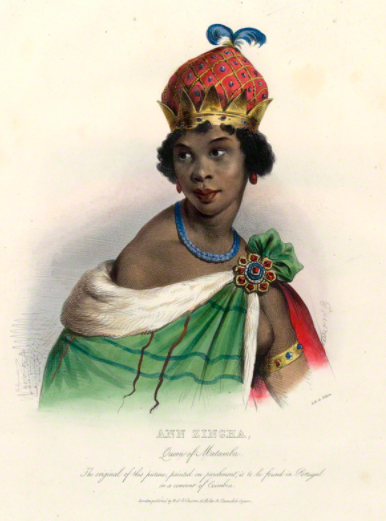Amanda DoAmaral
AP World History: Modern 🌍
577 resourcesSee Units
Internal and External Challenges to State Power
As states expanded power, they were consistently met with resistance and rebellion. This is a constant in world history. People will always find a way to challenge state power, especially when survival is at stake.
Here’s a few examples of how states were challenged between 1450-1750:
🎥Watch: WHAP - Resisting Empires on Land and Sea
Queen Nzinga vs. Portuguese colonizers
After the British and Dutch pushed the Portuguese out of India, they turned their attention to expanding their role in the African slave trade. In order to resist the Portuguese, Queen Nzinga of Ndongo (present-day Angola) initially made an alliance with them in order to protect the imports of guns for her people #girlpower.
Over time, the Portuguese became more exploitative to expand their powers. Queen Nzinga turned to the Dutch to help fend off the Portuguese. Together, they defeated the Portuguese in 1647, but the Dutch retreated from central Africa a year leaving the region vulnerable.
Even into her 60s, Queen Nzinga personally led her troops into battle to protect their land. After her death, the Portuguese gained control of the region until well 1975.

Image Credit: wikipedia
Serfs vs. Russian Central Government
While the West African people were defending themselves from foreign attacks, the Russians were dealing with internal challenges. Russian serfs had suffered oppression from the time of the Mongols and by the 15th century, the hardship and population of serfs had increased.
Free peasants affected by heavy debts often lost their land and were forced into serfdom. Even as serfdom was abolished across Europe, Russian serfs were tied to the land through strict laws that had no opportunity for freedom. Escaped serfs began to organize as free peasants, especially in the steppes. They were called Cossacks.
The Cossacks under Yemelyan Pugachev rebelled against Catherine the Great. Although they experienced early success in their revolt, the Russian government eventually suppressed the rebellion. After that, oppression of peasants and serfs increased in an effort to avoid future conflict.
Maratha (Hindu warriors) vs. Mughal Empire (Muslim)
South Asia, which includes modern-day India, Pakistan, and Bangladesh, has a majority population of Hindus and a strong minority of Muslims. However, in the 17th century, the Mughals were a Muslim group that ruled the region.
In fear of minority rule, Hindu warriors called the Marathas rebelled. Between 1680-1707, the Maratha rebellion continued until they killed the Mughal leader Aurangzeb. His death effectively ended the Mughal Empire and the Maratha Empire ruled until 1818.
Pueblos vs. Spanish
In the Americas, Indigenous groups rebelled against European conquest. In present-day New Mexico, the entire Pueblo community rebelled against the Spanish for 10 days in 1680.
The Pueblo Revolt was successful and the Spanish retreated from the region. However, they returned in 1692 to recapture the lands. Some Pueblos again resisted, but the Spanish quickly massacred the small group of warriors. After that, many Pueblos migrated away in search of freedom.
Slaves vs. Slave Owners
Jamaica had a growing slave population throughout this time period. In 1655, the British took control of the land forcing the Spanish out. As Spanish slave owners fled, many slaves escaped and formed settlements called Maroons. Revolts led by maroon communities had some success, but were ultimately squashed.
The Gloucester County Rebellion in 1663 was the first slave revolt in the British American colonies. African slaves forged an alliance with white indentured servants in a rebellion to demand freedoms.
The revolt in Virginia failed and had serious consequences. In order to prevent white and black oppressed groups from conspiring, the Virginia government wielded racist policies to drive a wedge. They gave lower class white workers some rights to appease them and prevent further chaos. Black slaves remained enslaved for 200 more years.
Indigenous Tribes vs. British Colonists (Metacom’s War)
Native American tribes in New England were some of the first indigenous communities to be displaced by British colonists. The last stand against colonization was led by Metacom, also known as his colonial name King Phillip.
By the 1670s, the colonists and Natives had largely co-existed. However in 1675, Metacom mounted one last effort to drive the British off the Native land. Many tribes participated, although some sided with the English.
The colonists defeated the Natives after 14 months of bloody rebellion. Relative to the total population, Metacom’s War is the deadliest in US history.
Glorious Revolution: English Protestants vs. English Catholics
Back in England, things were getting complicated. England was a majority Protestant country, but had a Catholic minority. In 1685, the Catholic King James II ascended to the throne and began enacting anti-Protestant policies.
William of Orange was backed by Protestants to overthrow him. Without any bloodshed, William and Mary II pressured James II into exile and took the throne. William and Mary accepted joint powers with parliament and signed the English Bill of Rights. This is what’s known as the Glorious Revolution.
Rebellions & Revolts
State | Notable Challenges |
Portugal |
|
France |
|
Russia |
|
Mughals |
|
Spanish |
|
British |
|
Browse Study Guides By Unit
🐎Unit 1 – The Global Tapestry, 1200-1450
🐫Unit 2 – Networks of Exchange, 1200-1450
🕌Unit 3 – Land-Based Empires, 1450-1750
🍕Unit 4 – Transoceanic Interactions, 1450-1750
✊🏽Unit 5 – Revolutions, 1750-1900
🚂Unit 6 – Consequences of Industrialization, 1750-1900
💣Unit 7 – Global Conflict, 1900-Present
🥶Unit 8 – Cold War & Decolonization, 1900-Present
✈️Unit 9 – Globalization, 1900-Present
✏️Frequently Asked Questions
🚀Thematic Guides
🗺Regional Guides
🤓Historical Thinking Skills
🧐 Multiple Choice Questions (MCQ)
📋Short Answer Questions (SAQ)
📝Long Essay Questions (LEQ)
📑Document Based Questions (DBQ)

Fiveable
Resources
© 2023 Fiveable Inc. All rights reserved.